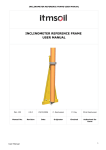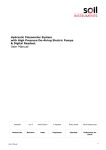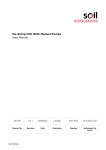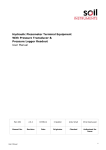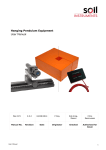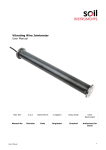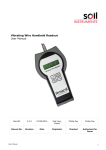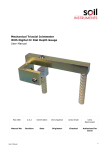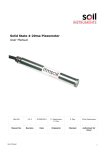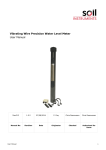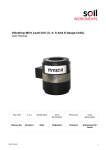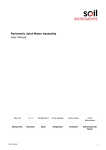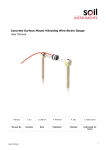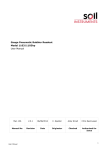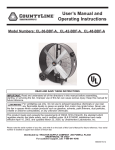Download MAN-104 De-Airing Unit with Electric Pumps
Transcript
Portable High Pressure De-Airing Unit Electric Pumps and Manual Pumps User Manual Man 104 4.0.1 04/08/2014 Phil Day Andy Small Chris Rasmussen Manual No. Revision Date Originator Checked Authorised for Issue User Manual 1 Contents Section 1 :General Information .......................................................................................................... 3 Section 2 :Positioning Of The Portable De-Airing Unit .............................................................. 4 Section 3 :Preparation And Setting Up ............................................................................................ 5 3.6 Repeat 3.3 to refill cylinder C .................................................................................................... 5 Section 4 :Operation and Recharging ............................................................................................... 7 Section 5 :Calculation of De-Airing Pressures .............................................................................. 8 Section 6 :The De-Aired Water Boiler ............................................................................................. 11 Appendix A.System Diagram (A3/2074-013).....................................................................12 Appendix B.27 Litre De-Aired Water Boiler (A4/145-00M) ................................................13 User Manual 2 Section 1 : General Information Refer to Drawing No. A3/2074-013. The de-airing unit consists essentially of pressure, supply and return tanks (A, B and C) and gauges to measure water pressure and vacuum during circulation of de-aired water. All these components are mounted on a frame or panel complete with valves and connecting pipework. Pressure and vacuum pumps are used to operate the equipment. Pressure is applied to the deaired water in supply tank B by forcing water from the pressure tank A into the bladder in B. Water from the supply tank may then be circulated through the piezometer tubes back to the return tank C. The volume changes measured in both the return and pressure tanks A and C indicate the quantity of water circulated through the system. The object is to completely replace the water in the piezometer tubes with freshly de-aired water. The equipment has been fully tested to However, it is possible that movements valves sufficiently to cause small leaks observed during operation they should component. the operating pressure and vacuum before despatch. during transit may disturb the cylinders, pipework or when the equipment is operated. If any leaks are be eliminated by gently tightening the appropriate Never modify the arrangement without the full written approval of Soil Instruments as unauthorised modifications may bypass the safety system. It is advisable to drain water from the equipment during cold weather to prevent damage to the cylinders due to freezing. WARNING If an anti-freeze solution is used, the system must be flushed with clean water to prevent the bladder from perishing over time. WARNING External high pressure gas cylinders must not be connected to this de-airing unit. User Manual 3 Section 2 : Positioning of the Portable De-Airing Unit The unit should be positioned on level ground and close to the terminal panels. The manifolds on the piezometer terminal panels should be connected to the busbar tee-piece connections on the de-airing panel. Blank-off the other side of the tee-pieces with the stop-end fittings provided. Place the vacuum pump to the right of the unit, the pressure pump to the left-hand side. The pressure pump (Foot Type) connects to the Schrader fitting on valve K. For standby use in the event of electric power failure. User Manual 4 Section 3 : Preparation and Setting Up It is essential to operate the valves in the order stated. Initially all the valves should be closed. 3.1 Close all valves. Attach the vacuum pump with the black hose supplied to valve F. Open valves F, G and N and apply vacuum until the bladder in cylinder B is completely evacuated, on solid cylinders this is indicated by an increase in resistance when operating the vacuum pump. Close valves F, G and N. 3.2 Immerse one end of the red rubber tube into a container of clean water and attach the other end to valve K at the base of the pressure tank A. Open valves K and F and operate the vacuum pump drawing the water into A. When this tank is 90% full, close valves K and F. Remove the vacuum pump from valve F, open valve F to release the vacuum, and then close. The de-airing unit is operated with two electric pumps and a boiler which require an electric supply (see separate sheet Drg.No. A4/145-000M). The electric compressor is connected to the pressure regulators via the tee piece between the regulators with the nylon tube provided. The electric vacuum pump is connected to either valves F, G or H as required during operation. The water boiler is positioned on the floor near tank C. 3.3 Prepare de-aired water in the de-aired water boiler, allowing it to cool. (See Section 5 and Figure 1.) Connect valve S on the boiler to valve M using the red rubber hose. Attach the vacuum pump to valve I, open valves I and M and release the vacuum from the boiler by opening valve V on the boiler. Open valve S on the boiler and by operating the vacuum pump slowly draw the de-aired water into cylinder C until it is 90% full. Close all valves. 3.4 Remove the vacuum hose from G. Remove the vacuum pump and open valve I to release the vacuum. Open valves G and L, attach the vacuum pump to valve G and draw the deaired water from cylinder C into cylinder B by operating the vacuum pump until cylinder C is only 10% full. Close all valves. To fill cylinder B completely it is necessary to repeat the operation but this time only half filling cylinder C with de-aired water. When cylinder B is almost full close all valves. Remove the vacuum hose from valve G, open valve G to release the vacuum, and then close. 3.5 Switch on the compressor and slowly screw in the lower regulator to bring the pressure in A to 5-10mH20. Open valve N and slowly open valve G thereby inflating the bladder, displacing the de-aired water in B and forcing out any remaining air. (If the air were to be removed by applying a vacuum at G there is a risk of damaging the pump by drawing water into it). Any bubbles of air that cling to the rubber bladder and walls of the tank B should be dislodged by slapping the sides of the tank until they rise and accumulate under G. They may then be removed with pressure in A and momentarily opening valve G. It is important that cylinder B is completely filled with de-aired water and all air excluded. Release pressure from A by switching off compressor, unscrew regulator open valve F. Close all valves. 3.6 Repeat 3.3 to refill cylinder C 3.7 Attach the vacuum hose to F, open valves F, N, L and I and apply vacuum to cylinder A, water is drawn from inside the bladder in cylinder B to cylinder A, thus drawing de-aired water from cylinder C into cylinder B. User Manual 5 When the bladder is fully deflated the tank A will again be 90% full of water. Close valves F, N, L and I. Remove the vacuum hose from F and release the vacuum in A by opening F. Close all valves. 3.8 Open valves I and M to drain the water from tank C. Close all valves. The de-airing unit is now fully charged with de-aired water and ready for operation. User Manual 6 Section 4 : Operation and Recharging Attach the vacuum hose to valve I. Operate the compressor and lower regulator until the desired pressure is reached in A, as indicated by the pressure gauge. Having calculated the optimum de-airing pressures, if a vacuum is required on the return side open valve K and operate the vacuum pump until the desired vacuum is reached as indicated by the vacuum gauge. Vacuum may be controlled by slightly opening the bleed Valve "S" under the vacuum gauge. Pressurised de-aired water from the supply tank B may be introduced into the piezometer terminal panels by opening appropriate valve on the panel. During operation of the unit the bladder in tank B should not be allowed to distend to more than three-quarters of the volume of the tank. At this point it is necessary to recharge with de-aired water as follows: 4.1 Close terminal panel valves to isolate the manifold/manometer from the de-airing unit. 4.2 Open valves F and I to release the pressure and vacuum from the tanks, as indicated by zero readings on the gauges. Close all valves. 4.3 Drain tank C by opening I and M. 4.4 Attach the vacuum hose to I and the de-aired water supply to M. Operate the Vacuum pump and draw de-aired water into C until three-quarters full. Close valves M and I. 4.5 Continue as in Sections 3.6. and 3.7 ensuring that the water in C does not empty while being drawn into B (avoid drawing air into B). Applying Back Pressure to Return Cylinder C On some occasions it may be necessary to apply a controlled back pressure to the return cylinder to maintain equilibrium of pressure at the piezometer tip when circulating de-aired water. This procedure is used to minimise the effect of forcing water into the soil surrounding the piezometer. To apply the required back pressure to cylinder C close Valves I and R, open valves Q and S. Adjust pressure applied to cylinder C by operating the top regulator until the required back pressure is obtained. On completion of the de-airing operation ensure that top regulator is fully unscrewed and valves Q and S are closed. User Manual 7 Section 5 : Calculation of De-Airing Pressures Consider a piezometer tip in the soil during the de-airing process as follows: u = pore pressure in the fill at the tip. p = pressure on the pressure side of the de-airing apparatus. v = pressure on the vacuum side of the de-airing apparatus. h = difference in head between the tip and the pressure and vacuum gauges on the de-airing apparatus. fAB and fBC = friction losses in the piezometer tube All pressures are measured with respect to atmospheric pressure. For Equilibrium:p = h + u = fAB v = h + u - fBD Since AB = BC, and if no water flows in or out of the tip the velocity will be the same throughout the system then:fAB = fBC p = 2 (h + u) -v In a piezometer installation h is known, v can be maintained at a known value, and u for each tip can be estimated using previous pore pressure reading. In this way p can be calculated for each piezometer and de-airing carried out at the appropriate pressure. If the piezometer lies below the readout point, the term h, the difference in head between the tip and pressure and vacuum gauges on the de-airing apparatus, changes sign and becomes negative. When a piezometer has accumulated a lot of air, care should be taken to apply sufficient pressure to drive water at least as far as the tip before applying a vacuum to other lead, as the friction loss in the return tube carrying air is much less than in one carrying water, and air will be drawn in through the tip from the fill. User Manual 8 Example 1. Where p = 2(h + u) -v p = 2(10 + 5) –v p = 30 - v Therefore for v = o p = 30 mH20 for v = -5 mH20 p = 35 mH20 for v = -10 mH20 p = 40 mH20 User Manual 9 Example 2. p = 2 (h + u) -v p = 2 (-7 + 4) -v p = -6 -v Therefore for v = o p = -6 mH20 for v = -5 mH20 p = -1 mH20 for v = -10 mH20 p = 4 mH20 User Manual 10 Section 6 : The De-Aired Water Boiler Refer to Drawing No. 145-000M. Up to 27 litres of the de-aired water can be prepared in the boiler at one filling. An integral immersion coil heats the water to boiling thus expelling any air or gases in solution. By sealing the boiler and allowing it to cool, the steam and water vapour above the water condense thus creating a partial vacuum inside the boiler. This prevents further solution of air or gases. 6.1 Remove the central filler-cap using the special double handled spanner provided. Open valves V and S. 6.2 Pour in clean water to within 100mm of the top. 6.3 Connect the electrical cable to a suitable AC mains supply having checked the voltage of the unit and the supply, switch on at the mains. Bring to the boil and allow to boil for fifteen minutes. Switch off at the mains supply. 6.4 Close valves V and S and replace the central filler-cap. Allow to cool. WARNING: Although the cap is fitted with a pressure relief valve, never boil with the filler-cap on. NOTE: With a partial vacuum inside the boiler, never open valve S before opening valve V, as this will draw air into the de-aired water. SAFETY REQUIREMENTS: The 4 psi Pressure Relief Valve in centre of filler cap must be checked at intervals not exceeding 12 months by a competent person. POWER SUPPLY:The 110 volt unit requires 110V, 60Hz, 30 Amps per heater element. The 240 volt unit requires 240V, 50Hz, 15 Amps per heater element. The units must always be earthed. Bell Lane, Uckfield, East Sussex t: +44 (0) 1825 765044 e: [email protected] TN22 1QL United Kingdom f: +44 (0) 1825 744398 w: www.itmsoil.com Soil Instruments Ltd. Registered in England. Number: 07960087. Registered Office: 5th Floor, 24 Old Bond Street, London, W1S 4AW User Manual 11 Portable High Pressure De-Airing Unit Electric Pumps and Manual Pumps Appendix A. System Diagram (A3/2074-013) - User Manual 12 Portable High Pressure De-Airing Unit Electric Pumps and Manual Pumps Appendix B. 27 Litre De-Aired Water Boiler (A4/145-00M) VALVE 'S' VALVE 'V' FILLER CAP IMMERSION HEATER CABLE TO MAINS SUPPLY T.MILLWA RD DE-AIR ED WATER BOILER 6/3/2002 1 REDRAWN DJP NTS 145-000 d w gs \1 4 5\ 00 0 --- -1 .d w g User Manual 1 1 1 13













